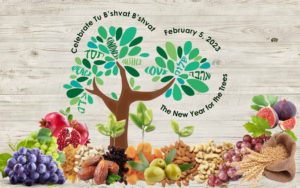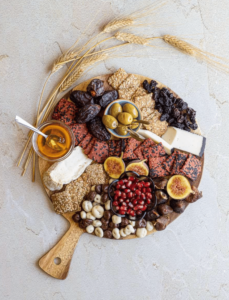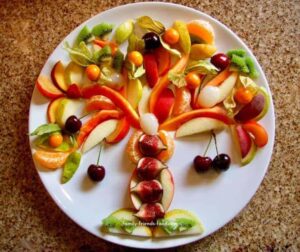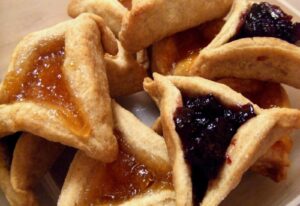Harris Equipment
2040 N. HAWTHORN AVE
MELROSE PARK, IL 60160
(708) 343-0866
harrisequipment.com
2040 N. HAWTHORN AVE
MELROSE PARK, IL 60160
(708) 343-0866
harrisequipment.com
Injury Law Made Personal®
ankinlaw.com
620B ACADEMY DR
NORTHBROOK, ILLINOIS 60062
(847) 940-4000
marketjd.com
Manual labor provider for every Delivery Day
1400 W. HUBBARD ST. SUITE 200
CHICAGO, IL 60642
(800) 423-5595
elitestaffinginc.com
Provider of dumpster and recycling services during our delivery
6132 OAKTON STREET
MORTON GROVE, IL 60053
(773) 685-8811
lrsrecycles.com
Providing all our mailing envelopes
1700 AVERILL RD
GENEVA, IL 60134
(630) 262-8080
continentalenvelope.com
BEN GURION WAY, 30 S. WELLS STREET
CHICAGO, IL 60606
(312) 346‑6700
www.juf.org
Providing all the boxes for delivery each holiday
7950 JOLIET RD #100
MCCOOK, IL 60525
(312) 829-4545
wertheimerbox.com
Barack Ferrazzano Kirschbaum Nagelberg LLP
bfkn.com
Tu B’shvat takes place on the 15th of the month of Shevat. (February 5, 2023), A minor Jewish holiday, it is often referred to as the “new year” or “birthday” of the trees. Its customs are simplistic, however, it’s meaning can be quite monumental.
On Tu B’shvat it is customary to eat at least 15 varieties of fruits and vegetables. It is important to include the seven species mentioned in the Torah: wheat, barley, grapes, figs, pomegranates, olives, and dates. These foods symbolize God’s creation, and by eating them, we give thanks to Ashem and reaffirm our ties to the Land of Israel. Scroll down for some fun food ideas.


Edible Planters
These edible planters by Jamie Geller (@JamieGeller) will have your Tu B’shvat seder guests wowed! Follow us on Instagram @maotchitim to get full recipe for these festive edible planters.
Liven up your oatmeal by adding, nuts, figs, pomegranate seeds, cherries etc for a delicious Tu B’shvat breakfast.

Charcuterie board idea for Tu B’shvat
Charcuteries are all the rage! Looking for an excuse to make a beautiful charcuterie board? No better time than Tu B’shvat! Dried fruits, nuts, cashew vegan cheeses, olives, wheat and barley crackers, pomegranates, figs and grapes will make a beautiful display. Get your whole family involved and see how creative you can be.

Looking for fun ways to celebrate with kids? PJ’s Library has loads of ideas.

Have fun with this holiday. Celebrate the Earths bounty. Learn something new. Grow some plants and your spirit.
Please Give Back
On Tu B’shvat it is customary to donate money to plant trees in Israel. Along with this tradition, we kindly ask you to help grow and renew the spirit of those in need by donating to help bring food for those unable to afford to do so. Thank you for your generosity. You can donate online.

Hanukkah is right around the corner. There is so much more to the Festival of Lights than eight days of gifts (for the adults among us, at least—we know children simply love exchanging presents) Here are ways we want to encourage you to enjoy this season with some fun and games!
Members of our community celebrate Hanukkah in many ways. Most light one candle for each night of Hanukkah on the menorah for 8 nights. Others also include singing special hymns and reading Jewish scripture. Whatever you choose, there are compelling options for the whole family.
Here are some of the traditions you might include in your Hanukkah celebrations:

Spin the dreidel, a small spinning top with Hebrew letters inscribed on all four sides, where it will land, nobody knows. Think of all the games you can play! If you need a refresher, you can download this free cheat-sheet of the official Dreidel rules here!

Gelt is the Yiddish word for money. Some people know the term because it refers to the famed foil-wrapped chocolate coins often exchanged over Hanukkah. Be sure to stock up and use it to play the Dreidel Game
Oil, originally used to light the menorah, plays a starring role in many of the foods we eat during Hanukkah. Get creative with potato latkes, sufganiyot (delicious jelly donuts), and other delicacies. You can find many Hanukkah recipes in our Maot Chitim Cookbook. Sign-up to receive your free e-cookbook here.

Whether you prefer to volunteer your time or sponsor a meal for those less fortunate, you can help other Jewish families in our region celebrate Hanukkah the way they deserve.
The festival of Purim commemorates when Esther, the Queen of Persia saved the Jews from extermination by Haman, the advisor to the Persian king. Esther had previously hidden her Jewish identity from her husband and saved the Jews by bravely revealing her identity and informing the king of Haman’s plan to wipe out the Jewish population.

THE CELEBRATION
In modern times, the holiday is known for its celebratory atmosphere that includes the reading of the Megillah (the story of Esther and Haman), costumes and carnivals. The story of Purim includes many elaborate feasts, so it comes as no surprise that there are many symbolic foods related to the holiday as well

One of the most iconic symbols of Purim is hamantaschen which are triangular shaped cookies that are said to represent Haman’s three-cornered hat. Hamentaschen can be filled with fruit, nuts, chocolate, or a more traditional poppy seed paste. It has been said that taking a bite out of a hamentaschen cookie can be seen as an act of defiance of bowing down to Haman and preventing him from carrying out his plan.
Eating triangular shaped foods during Purim is a popular tradition for Ashkenazi Jews which is one of two reasons that Kreplach, triangular dumplings filled with chopped meat, are eaten during this holiday. The second reason is that the filling hidden inside of the dough is symbolic of the secret that Queen Esther kept or that the hidden nature of the kreplach interior represents the hidden nature of the Purim miracle.
Purim is also associated with drinking wine. But why is that? According to Haaretz.com, “The custom of drinking wine on Purim stems from a quotation in the Talmud attributed to a fourth century Rabbi, Rava: ‘One must drink on Purim until that person cannot distinguish between cursing Haman and blessing Mordechai”
SHALACH MANOT – a Purim gift

Lastly, shalach manot is another food-related tradition of Purim. Shalach manot are Purim baskets typically filled with sweets but can include other types of food that are considered “ready to eat”. The mitzvah of giving these baskets derives from the Book of Esther and is meant to ensure that everyone has enough food for the Purim feast typically held later in the day. The Book of Esther instructs that Purim is a time for “feasting and joy and giving presents of food to one another”
There are three different mitzvot mentioned in the Book of Esther: 1) Eating a Purim meal. 2) Sending shalach manot to a friend. 3) Distributing charitable donations to those less fortunate. This Purim as you prepare to fulfill the three mitzvot, please consider giving a monetary gift to Maot Chitim of Greater Chicago to ensure those that need food will have food on their table.
At Maot Chitim we’re sharing three wholesome, tasty, tried-and-true dishes that will look beautiful on your Sukkot table under the stars.
The Jewish harvest festival is approaching! Sukkot, which translates as booths or huts, commemorates the years when the Israelites wandered the desert after fleeing Egypt under G-d’s protection. The solemn high holidays of Rosh Hashanah and Yom Kippur are followed by the more light-hearted Sukkot which is marked by a week of joyous celebration and Simchat Torah, the last of the high holidays.
Between building a temporary outdoor structure known as a sukkah, choosing a lulav & etrog, and preparing meals for this seven-day holiday, Sukkot can be quite an ordeal. That’s why people often choose easy recipes that allow for quick meal prep.
We chose these three dishes because of their connection to the seasonal holiday. Fall-friendly sweet potatoes complement the kale salad perfectly with its thick garlic-mayo dressing and crunchy topping. Lemon juice prominently features throughout as it is very reminiscent of the etrog or citron, one of the Four Species (lulav and etrog) that we use on Sukkot. Enjoy!
This recipe is a little like Caesar salad but with kale instead of Romaine lettuce. The dressing tastes similar and the crunchy topping adds depth. There is no cheese so it works well for a traditional yom tov meal featuring meat or chicken. Definitely a crowd-pleaser.
Ingredients:
Dressing:
Sweet Potatoes:
Heat oven to 425. Peel and cut sweet potatoes into quarter- or half-inch pieces. Coat with olive oil, salt, pepper, and garlic powder. Bake until roasted, about 30-40 minutes. Remove, cool, and set aside. When ready to serve, mix kale with dressing and then add sweet potatoes. Top with croutons and other mix-ins.
Chicken is such an easy protein to serve during the holidays and is synonymous with comfort food. This recipe can be made in advance as it freezes well.
Ingredients:
Directions:
Preheat the oven to 350.
Peel and cut up potatoes for the bottom of the pan. Place chicken on top of the potatoes. In a separate bowl, mix the diced tomatoes, sliced shallots or onions, juice from one lemon, red wine, garlic, soy sauce, and olive oil. Then pour the mixture over chicken.
Bake covered for 45-60 minutes and uncover for 20-30, depending on preference.
This classic Jewish holiday dish is a great way to use up any leftover apples from Rosh Hashanah. Originally full of sugar, it easily adapts to more health conscious sweeteners and can even be gluten free! Try substituting half honey, half maple syrup for a rich fall flavor. Using a glass pan for this recipe really makes a difference, although it will still be delicious if you don’t have one.
Ingredients:
Directions:
Preheat the oven to 350. Mix the eggs, sugar, lemon juice, and salt together in a large bowl. Peel and slice apples into thin quarter pieces, about 1 to 2 inches long. As you cut, add apples to the mixture to keep them from turning brown.
Pour oil into a glass pan until it covers the surface, using either a 9×13 or 10×15. (Note: kugel tastes better in a 10×15 pan because it comes out thinner). Alternatively, you can use three shallow 9-inch pans. Heat the pan for about 10 minutes. While it’s heating, add the matzah meal/almond flour/potato starch to the apple mixture, and stir to combine. Do this just before baking. When the oil is hot, carefully remove pan from the oven and pour it into the apple mixture. Gently mix and then spoon it all into the hot pan.
Bake at 350 for 40-50 minutes, or until golden brown on top.
Click here for more information about Sukkot and how to prepare for it.
At Maot Chitim, we’re all about helping people improve their high holiday experiences, and that starts with food. Please drop a comment below or email us about how these recipes turned out.
We hope you’re all staying healthy during COVID-19.
Wishing you a good yom tov and chag sameach (happy holiday)!
It’s hard to believe it, but we’re already getting ready for Thanksgiving. We’re all about celebrating holidays at Maot Chitim, and we can’t think of a better way to celebrate a holiday than to practice gratitude. These are just a few of the things that we’re giving thanks for this Thanksgiving.
1. The Chicagoland Jewish community
We like to think that our Jewish community here in Chicago is pretty special. We love when the whole community comes together to celebrate, especially for our Rosh Hashanah and Passover deliveries. Our community is the perfect balance of diverse and close-knit.
2. Delicious food
It’s easy to stress about the intricacies of Thanksgiving dinner, and easy to take for granted that we even get to have such an extravagant meal, or really any meal at all. We are reminded of this when we deliver packages to those who need it for the Jewish holidays, but it’s important to remember year-round.
3. Warmth
During this unseasonably cold fall season, let’s be thankful for warm clothes and heating in our homes. It’s easy to complain about the cold every time we walk outside, but it would be even more uncomfortable without winter coats.
4. Shelter
There are many things to worry about on a daily basis, but we should be grateful if stressing about where to stay at night is not one of them. Even though houses are a huge responsibility and burden, they are also a privilege.
5. Family
Thanksgiving is, for many people, one of the only times when the whole family can be together. This can cause drama or tension, but at the end of the day it’s important to acknowledge the blessing of getting together as a family.
There are so many ways to practice gratitude this November. You can start a journal or share something you’re thankful for at your Thanksgiving dinner. A great way to turn your gratitude into something tangible is to help others who need help with basic necessities this winter by donating to organizations who are doing work to end hunger and homelessness. Happy Thanksgiving to all!
Why do people volunteer? The obvious answer: people volunteer because they want to help other people from the bottom of their hearts. The not-so-obvious answer: the volunteers themselves experience a wealth of personal benefits. Here are five surprising things benefits volunteers gain from their service:
1. New friends
Making friends is even easier for volunteers because they already have something in common: their passion for the same cause! People who consistently volunteer at the same organizations start interacting with the same people and form a community. Volunteering is also a great way to get connected to a new area after moving.
2. Career experience
Employers love well-rounded job applicants who are involved in organizations outside of their workplace. Volunteering is a great way to show off your versatility and learn resume-worthy skills. On top of all the friends that volunteers make (see benefit 1), people who volunteer regularly are more likely to meet valuable career contacts who can help them land new jobs. Nonprofits are the perfect place to start networking, especially for those looking to enter a new career field.
3. Exercise
Manual labor is always in high demand at nonprofits. Even though it isn’t the most glamorous job, it is mutually beneficial. Organizations couldn’t run without it, and it serves as a thorough workout. Not convinced? Volunteers have lower mortality rates, blood pressure, and heart disease risk than non-volunteers.
4. Happiness
Studies have shown that being helpful to others releases endorphins that make people feel happy. Recipients of volunteer work often praise the volunteers for their generosity and selflessness, which makes them feel great about themselves. Everyone can use a self-esteem boost every once in a while!
5. A sense of purpose
The feeling of appreciation from recipients make volunteers feel needed by others. This motivation to get out of bed in the morning is especially for people who are going through hard times. If people feel like their work is genuinely important, they will do whatever it takes to complete it.
Maot Chitim has a uniquely heartwarming volunteer environment that, in addition to the listed benefits, keeps our volunteers coming back year after year. To hear the stories of some of our volunteers, check out our Instagram and Facebook every Monday for a “Humans of Maot Chitim” post. Sunday, September 22nd is our 2019 Delivery Day and we would love to see you there.
There was a time in my youth where the phrase “community service” only signified some kind of mandated punishment. To me, there was no benefit that I would experience from doing volunteer work. I felt that the only people benefiting from this activity were either the people who would receive the fruits of my labor, or the organization itself. I was immature and wrong.
After I graduated from high school and had the opportunity to leave the sheltered suburbs of my childhood, my perspective on community service slowly began to shift. This was an important period of time where I could redefine my identity. I took specific moments to reflect on who I was, how I impact those around me, and who I wanted to be.
My honest reflection revealed that I was pretty darn selfish for the first 18 years of my life. My parents were supporting me financially and I really only focused on baseball, school, and my friendships. I spent virtually all of my time focused on myself. After my period of reflection I felt that I needed to change my contribution to those around me. I had time that didn’t need to be devoted to myself. Initially, I tried spending more time with family and doing more work around the house when I was home, though, these attempts at filling the “selfish” void felt unfulfilling. My “ah-ha moment” came during the first semester of my sophomore year at Denison University. As a member of the baseball team I was granted the opportunity to read to kindergartners of the Newark Ohio school district that winter. To give some context, the Newark area has experienced a bought of poverty over the last 30 years, and most of these students were from disadvantaged families.
On a cold February morning, 2 teammates and I read a short story to two different groups of students in the Newark library basement. After finishing the story, we were told to stress how smart the students were and that a college education is a worthy goal. I was blown away with the impressionability of the children and how much I felt that afternoon had positively impacted their psyches. Not only did I feel that the students benefited from our volunteer work, but this feeling itself made ME feel good. I had never volunteered in a way where my actions directly helped someone sitting next to me. This experience made me want to continue giving back to the communities in which I’m a member, and even to those that I am not.
The moral of this story is that community service can be a mutually beneficial endeavour. Volunteer work isn’t a punishment, it is awesome. Not only does it help those who are in need, but it also creates a positive legacy for you. Ask yourself the question “how will I be remembered”? Was I a selfish guy who never lent a hand, or was I someone who improved the lives of others? This specific time was important to my development as a person, yet it can take place at any time for any person who chooses to reflect honestly. Organizations desperately need volunteers and those who volunteer benefit as much, if not more than those they are serving.
Nonprofit organizations are always looking for innovative and exciting ways to raise money. When organized exercise became popular in the sixties and seventies, nonprofits used the trend to gain enthusiasm for their causes. Americans loved the idea of using charity as a motivation to take on physical challenges, and the idea caught on quickly. Here is a brief timeline of exercise as a fundraising method:
1970: The first nationwide charity walk, March for Babies, raises $75,000.
1985: Relay for Life is founded and introduces the concept of fundraising teams to exercise fundraisers.
1988: As running gains mainstream popularity, the Leukemia and Lymphoma Society starts sending runners to destination races if they can reach fundraising goals.
1998: The first Avon walk for breast cancer inspires thousands of dedicated participants to return year after year.
2009: The first Warrior Dash, benefiting St. Jude Children’s Research Hospital, is a mud-filled obstacle course extravaganza. Crazy, messy, and unique exercise fundraisers start popping up everywhere.
2011: Charity Miles, an app that donates money to a charity of the user’s choice for every mile they run or bike, is created. Today, people can be motivated to donate money through exercise without signing up for a race.
Over the years, exercise-based fundraising has come a long way. Coming up on June 30th, Maot Chitim board members will be participating in the Midwest Charities Midwest Charity Ride. We will Bike to Feed the Hungry, benefitting Maot Chitim and several other Jewish charities. We are thrilled to have the opportunity to participate in this fun event and hope to see you there! More information can be found at MCRide.org.
The very heartbeat of a non-profit organization is its volunteers. While some charitable organizations offer food delivery and nourishment for their communities, Maot Chitim of Greater Chicago volunteers provide nourishment to hearts and souls.
Many people think kosher foods are simply blessed by a rabbi, but there is much more involved in kosher food production. You can see why their prices prohibit many of our Chicago-area neighbors from traditional worship:
…Most reliable kosher agencies require full-time supervision for Passover production. And it’s not just for the finished product, but for each of its ingredients. Take, for example, that expensive bottle of ketchup. …Not only does the ketchup have to be made under full-time supervision for Passover, but so do the spices, vinegar, and oils that flavor it. …In just about all the cases, companies must clean production equipment thoroughly to get rid of any non-kosher-for-Passover ingredients. –Benyamin Cohen
This year our warehouse is located at 7080 N McCormick, in Lincolnwood. We will be delivering enough food to feed over 15,000 people. Please join us on March 25th!
If you’re looking for Purim hats or costume ideas, you can’t go wrong with Pinterest. And if you’re planning a party, be sure to include Purim Song by the Maccabeats. Festivity, hats and costumes, gift baskets, the Megillah, and hamantaschen are what we think about when it’s time to celebrate Purim.
As if we needed an excuse to eat cookies? The story goes that Haman the Agagite wore a 3-cornered hat. So we celebrate his demise by eating his hat.
Research by renowned scholars into the tradition of hamantaschen for Purim, which goes back to the Middle Ages and for which the exact translation is “Haman’s pockets,” has never been explained. But the Swedes “have a suspiciously similar cookie, called Napoleon’s Hats or ‘Napoleonhattar,’ which are traditionally filled with almonds. That actually makes a certain degree of sense: Tri-cornered hats were popular in Napoleon’s time,” says Jewcy.
Author Lawrence Cohen says for his rabbi, wearing a funny hat to the reading of the Megillah is “…the supreme mitzvah. Visiting the sick, accompanying the dead, attending the bride, don’t even come close.” In fact, rabbis are so divided on the why-do-we-wear-the-hat topic that at one historical point they declared Teyku (“Let the decision be made by Moshiach when he comes.”).
Another theory reigns: The hats are supposed to represent the crown of King Ahasuerus, who decided to kill Haman rather than the Jews. His decision may have been self-serving: He wanted to keep his wife Esther around, but we remain happy he chose that option.
If you have the real reason we wear funny hats to celebrate Purim, let us know! Meanwhile, we wish you and your family and friends Chag Purim Sameach! Wear a funny hat Thursday, March 1, 2018. Another Mitzvah for Purim is Matanot L’evyonim, which translates to donations to the poor or charity. You can donate to Maot Chitim of Greater Chicago by clicking here.
It’s a mitzvah.
You are following those who cared for you, taught you, loved you . . . The ones who left a legacy for you. Now, it’s your turn. Leaving a legacy is important! Think about the people who ensured a legacy for us:
These are the people who have shaped the way you live today, and many of them may have left you both memories and legacies you won’t soon forget. Living a good life means taking what you have and making it what you want it to be.
All of us are leaving legacies to those who follow; most of us have strived to live moral, healthy lives without harming others – and when possible, helped others. Here’s why we should remember that our legacies are important:
Leaving a legacy is an act of responsibility. Good men and women don’t simply leave behind good or bad memories (legacies) for others. They create their legacies by building a life founded upon caring enough about others to leave them a meaningful and positive legacy.
We are stewards of this world; we should leave it better than we found it.
We can curb our selfishness by thinking about the legacies we leave. Leaving money so that a hospital wing or art gallery bears your name is one thing. But when you donate that money in the true spirit of helping others, you’re helping yourself, too. Every day lived well, with a sense of purpose and a goal to help others increases your happiness and wellness.
As you sit near your fireplace or snuggle on the couch with your favorite afghan and a cup of warm tea, you feel safe and protected against the winter winds, hunger, and fear of famine. But did you know Jewish families live in poverty, close to your home? With your help, Maot Chitim of Greater Chicago has established a tradition of charity to our people in need for over 100 years. And now, if we raise enough new donations before June 30, 2018, Maot Chitim will receive an additional $10,000 through an incentive grant! When you join the Maot Chitim Legacy Society, your gift will sustain Chicago-area Jewish families in need for many years. Your bequest can be included in:
Call 847.674.3224 or contact Maot Chitim of Greater Chicago today to help us meet the requirements of this incentive grant.
There are certain things we can only do together. -Barack Obama
The concept of volunteering is difficult to explain to a small child, but they appreciate that helping others is a good thing. By the age of 4, most children understand, “I need help with dusting furniture,” and many can say, “I need a volunteer…”
Tips to Involve Children in Volunteering
Our friends at PBSparents offer the following tips to help you teach your child the value of volunteering:
Charity Begins at Home (Chicago)
We need volunteers to package and deliver food to those who are unable to afford sometimes-expensive foods need to worship in a traditional, Jewish manner at home. Our Passover Delivery Day is March 25th, 2018. It’s a wonderful experience for the entire family. Contact Maot Chitim of Greater Chicago to learn more.
For most household budgets, charitable donations fall under the category of “disposable income,” and that indicator isn’t quite as strong. Income is rising, but the growth rate of disposable income has been slow.
Most how-to-donate advice says to stop donating sporadic, small amounts and focus on one or two charities, building your donation into your budget so they can build their budget based on your donation. It makes sense! But make no mistake – there are no charities that will turn away donations of any size, and we’re not too proud to beg, either!
How to Help
Even if you’ve never made regular donations to a charitable organization, you can build financial support into your budget. Here’s how:
“The more you can align your actions with your beliefs, the happier you will start to become in every area of your life.” –Kate Dillman
Focus on your values and explore your passions. If easing hunger or preventing animal cruelty is something you would like to support, go that direction and research local, state, national, or international organizations.
Create a savings account called “Donations,” and begin stashing money in it every paycheck. No matter how tight you are that particular pay period or month, there’s always something; buying a grocery store pizza vs. home delivery saves you $10, for example. Ten dollars may not seem like much, but it adds up.
“Your sacrifice doesn’t have to be big.” –Jennifer Bernstein
Your venti mocha latte is almost $5/day or $150/month. Maybe you can make an adjustment in your budget and sacrifice one or two items often enough to make a difference to those who are needy.
If you’re like most people, it’s easier to save money when it is paycheck-deducted. Try to set up auto-deductions into your “Donations” savings account. Once you’ve built up a respectable amount, decide how much you want to donate, how often, and set it up on autopay. Your charity will jump for joy because your monthly or quarterly donation is something they can depend on! They can better balance their own budget, thanks to you.
If your company does not have a matching gifts program, make a case for your charity and their help! Even “We’ll think about it,” is better than nothing and may lead to…something.
Maot Chitim of Greater Chicago
If charity begins at home, you have Chicago-area neighbors who will need food and support for the upcoming Passover Holiday. You can help us help them. Contact us to learn more.

It’s back-to-school time for many families.
And for many Chicago-area students, 2017-18 is the year to focus on the future; career choices are abundant, but sometimes jobs are hard to find. If you want to hone your skills and get experience that makes a difference to potential employers, volunteering is invaluable:
The hub of volunteer activity for Maot Chithim takes place at our warehouse, located about 20 minutes from our Northbrook office at 7100 N. McCormick, Lincolnwood, Illinois. Last year, we aided over 30,000 recipients – people who would have been unable to worship in the Jewish tradition.
One week before a holiday delivery, volunteers gather at our warehouse to assemble boxes of non-perishable food. Warehouse volunteers must be at least 12 years old and must wear closed-toe shoes (no sandals or flip-flops) for safety. Not only can you volunteer yourself, but you can also coordinate your own group of volunteers! Warehouse packaging can be a way to actively interact with your book club friends while providing a very needed service.
Deliveries have been made so much easier and faster, thanks to cellphone navigation apps! There are no age restrictions for delivery participants; drivers should have a valid driving license and auto insurance. Drivers are needed – especially drivers with SUVs, vans, and trucks – to deliver to multiple addresses in Chicago and nearby suburbs.
As a student or job-seeker, your volunteering activities are an important part of your resume! If you would like to organize a group of people to volunteer for warehouse packaging or package deliveries, please contact our group coordinator at info@maotchitim.org. Even if you cannot volunteer in person, you can help Maot Chitim in many ways! Call 847-674-3224 or contact us today for more information.
Our Fall High Holidays are fast approaching! It’s a busy time of year for Jewish families, communities, and organizations like Maot Chitim of Greater Chicago. This year, Elul begins Monday, August 21. This is the perfect time for you, your children, and your grandchildren to begin holiday preparations. It’s also the perfect time to remember our older neighbors and those who are less fortunate.
Poverty and hunger don’t take a break during the holidays; if anything, the reality of impoverishment strikes those of our faith even harder. Special foods and our way of worship are deeply entwined whether we are celebrating or mourning. For Rosh Hashanah, round, braided challah bread symbolizes time’s annual cycle. During the month of Tishrei, bread and apples with honey represent our hopes for sweet things to come in the new year!
Your financial support and donations now, before the High Holidays of 2017 can help as many as 15,000 Jewish people worship and observe Rosh Hashanah and Yom Kippur meaningfully and joyfully. Their gratitude will be your blessing for the new year.
Your financial support goes beyond the holidays and into the hearts of those who live in poverty, and with hunger every day. Please call 847-674-3224 or contact us if you know of a family in need this time of year. Your referrals are another way to ensure others can worship traditionally.
Between Rosh Hashanah and Yom Kippur, we observe the Days of Awe (Yamim Noraim). This is a time in which we seek a closeness with God; a time for review of last year, atonement and repentance, reconciliation, and forgiveness. As you review what you could have done better or differently, know that when you help Maot Chitim help others, you’ll be blessed into the new year and beyond!
“I’d like to – but I don’t have time!” Charitable organizations hear that phrase repeatedly, and it once meant, “You’re not one of my priorities.” In today’s technologically advanced, fast-paced world of today, it’s true: we really don’t have much time! Data indicates that we spend 30% of our lives getting dressed and preparing to leave the house (three percent of us take over an hour)! Or, you might have the time, but perhaps you have a physical disability that limits movement and travel. Maybe not leaving the house to help your charity is the solution.
Ways to Help from Home
You can “change the world in your pajamas,” says Help from Home.org! The website has ways to help your chosen charities, and you can even select the amount of time you have available – from under 1 minute to multiples of 30 minutes. Here are ways to help from home:
Monetary donations continue to be the best help without volunteering. Contact us to learn more about ways to help Maot Chitim of Greater Chicago!
Volunteer Chima Madu said, “The fact that I am not paid does not mean that I am worthless. It means that I am priceless.” The joy – and blessing – of being a volunteer is that it’s a 2-way street. Serving others can change your life for the good.
Volunteers are needed to offset a charity’s overworked personnel and often, a lack of resources that means administrative staff does more hands-on work. In our case, that would be packing and delivering food boxes for our volunteer events, and we do so gladly and eagerly! But we need help for our volunteer events, and we need our volunteers to prepare themselves, physically and emotionally.
Volunteers are the lifeblood of Maot Chitim, but we don’t want our volunteers to bleed for us by any means! In order to serve as a packing/delivery volunteer, your vehicle and your body should be in good shape and adequately insured. Do not risk injury or illness as a result of any physical activity, no matter how worthy. Remember: You are priceless!
If you will be volunteering for 1 hour or 6 hours, the night before the event put out your water bottle(s), energy bars, raincoat, sack lunch and anything else you anticipate that will make your day go easily and comfortably.
You want to be an asset; not someone other volunteers have to “deal with.” Before the volunteer event, discuss procedures that experienced volunteers follow in order to best help the activity flow.
Charity is an option for many; for us, it is tzedakah. Even the best coordinated and organized volunteer event can hit some snags. Keep your sense of humor and remember our focus is to serve with a joyful heart! Your bumps in the road will hardly matter.
The best way to not feel hopeless is to get up and do something . . .
If you go out and make some good things happen,
you will fill the world with hope. You will fill yourself with hope.
-Barack Obama
Charity sees the need,
Not the cause.
We are taught it is our mission to help others. So we do. You’d think being a charitable person would, in itself, be a good thing but there are actually right and wrong ways to be charitable.
Personal finance writer Liz Weston says the best rule to follow when contributing to organizations that serve the needy is, “Take your time.” Shotgun-giving doesn’t help you make knowledgeable choices, and often the amount donated causes more problems than good. Here are three of the “charitable mistakes” many of us make:
By the time a $25 donation is processed, much less than $25 eventually trickles down to the needy. And any donation – no matter how small – indicates to a charity that if you are courted, you might give more. So the organization may spend twice as much as you donated trying to persuade you to increase future donations.
Rather than make one-time donations based on an emotional appeal, it’s best to focus on one or two organizations that represent your passion for good. Let’s say your focus is child abuse. Now, let’s narrow it down even further: does an organization like CASA (Court Appointed Special Advocates) or Lunches of Love (LOL) speak to your passion for helping needy children?
The year-end and new year holidays inspire us to be better people; we want to share some of our blessings with those less fortunate. Again, last-minute giving to random charities is not nearly as effective as regular donations to one organization. Your charity can build a budget around your regular donation when you make monthly donations. It helps with cash-flow, year round and better serves the needy than one larger donation at tax time.
No matter how heartfelt the request for charity, it’s simply best to avoid telemarketing and storefront solicitations. Maot Chithim of Greater Chicago is not a billion-dollar charitable industry with well-paid CEOs, so we get a big bang out of small donations! Call 847-674-3224 or contact us to learn more.
It’s tempting – and let’s admit it – too often, it’s necessary – to eat meals on the run. One woman said she only saw her husband when they passed each other in cars as they chauffeured their children to and from practices and lessons. “He would wave his taco, and I would wave my burger, and that was supper!” she recalled.
When you’re finally all together at home, the kids want to play video games, talk to their friends on cellphones, and you’re so tired you just want to zone out in front of the television.
The “family dinner” is an infrequent, special event to most of us. But there are two important reasons you can and should strive to have family dinners every week.
When you are an active, dynamic household, family dinners are just one of the ways you can stay connected with each other. Volunteering together, as a family, gives your children lifelong skills and humanitarian values that will serve them and their children for eons. Volunteering helps your family unit learn about their individual personalities, too!
Maot Chitim of Greater Chicago is an organization that has served family dinners and kosher meals to needy people in the Chicagoland area for over 100 years. We understand that “time is money,” and appreciate the fact that it’s often easier to donate financially. But the lesson still applies when you include your family in a donation: Our legacy is one of charity; it is your mitzvah (commandment) to help others with a willing heart.
Call 847-674-3224 or contact us to learn more about ways your family can help our family!
Helping others is a part of our culture. It’s also one of the ways we reinforce the importance of our traditions. Holiday volunteering is especially useful to youngsters; it helps them understand the blessings they have and the blessings they can be.
The first positive benefit that family volunteering offers is that it enables a dialogue among family members: How can we serve? What can we do? What are our unique talents? As you plan your volunteering-as-a-family activity, discuss these points:
The generationOn website says volunteering as a family helps your youngsters focus on things larger than themselves. Research confirms there are positive benefits for volunteers too, when they work with their family to help others.
Call 847-674-3224 or contact Maot Chitim to learn more about how your family can help. We know that your time is truly more valuable than money! If volunteering is not possible, your financial support can be a family project, too. And don’t forget to support our sponsors! We depend on their support and services, as we continue to help those who need us most in the Greater Chicago area.
Not all Chicagoland people are natives, and they may not realize what we were born knowing: how to stay warm this winter. Share these tips for surviving Chicago’s Winter 2017 with your neighbors/newcomers, and remember to follow them yourself!
Rabbi Elazar Muskin says we should “love kindness*.” You should not only willingly mitzvah; you should do so with warmth and happiness. Charity begins at home. For some of us, the world is “home,” but for many, home is an address or a country.
“Judaism . . . must also teach how to tithe with a smile,” says Rabbi Muskin. When you help others, you feel good about yourself! The volunteers and donors who support Maot Chitim of Greater Chicago are not only a blessing; they are blessed!
Even as we rejoice in the gifts God gave us, we need to help those who are cold and hungry. Chicago is home to many members of our Jewish “family” who are elderly, infirm, and needy. For them, home may be a very cold place that could use warmth inside and out.
*Micha 6:8